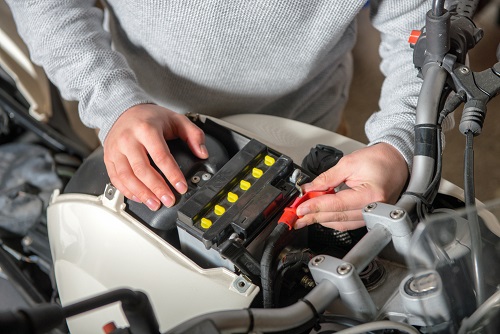Motorcycle batteries are the lifeblood of your two-wheeled adventure. Whether you ride a cruiser, sportbike, or off-road machine, having a reliable and powerful battery is crucial for starting your engine and powering your accessories. In this comprehensive guide, we will delve into the world of motorcycle batteries, exploring their types, features, maintenance tips, and key factors to consider when selecting the perfect power source for your ride.

Understanding Motorcycle Battery Types
- Motorcycle batteries come in various types, each offering unique characteristics and performance. The most common types include conventional lead-acid batteries, absorbed glass mat (AGM) batteries, and lithium-ion batteries.
- Conventional Lead-Acid Batteries: These are the traditional batteries, affordable and widely available. They require regular maintenance, such as checking electrolyte levels and topping up with distilled water. However, they offer reliable starting power and are suitable for most motorcycles.
- Absorbed Glass Mat (AGM) Batteries: AGM batteries are maintenance-free and designed to handle the vibrations and shocks experienced during motorcycle rides. They are sealed and spill-proof, making them a popular choice for riders who prefer hassle-free maintenance.
- Lithium-Ion Batteries: Lithium-ion batteries are lightweight, compact, and have a high energy density. They provide excellent starting power, require minimal maintenance, and have a longer lifespan compared to lead-acid batteries. However, they tend to be more expensive.
- Factors to Consider When Choosing a Motorcycle Battery Selecting the right motorcycle battery requires considering several crucial factors. Here are some key aspects to keep in mind:
- Battery Size: Ensure that the battery you choose fits your motorcycle’s battery compartment. Consult your motorcycle’s manual or check with a trusted mechanic to determine the correct size.
- Cold Cranking Amps (CCA): CCA indicates the battery’s ability to start your motorcycle in cold temperatures. In colder climates, a higher CCA rating is essential to ensure reliable starting power.
- Reserve Capacity (RC): RC measures how long a battery can provide power to your motorcycle’s electrical systems in case of alternator failure. Higher RC values mean a longer backup power supply.
- Durability: Look for a battery that is designed to withstand vibrations and shocks commonly experienced during motorcycle rides. A durable battery will have a longer lifespan and provide reliable performance.
- Maintenance: Consider the level of maintenance you are willing to undertake. If you prefer a maintenance-free experience, opt for AGM or lithium-ion batteries.
- Motorcycle Battery Maintenance Tips Proper maintenance can significantly extend the lifespan and performance of your motorcycle battery. Follow these tips to ensure your battery remains in top condition:
- Regular Inspections: Check your battery regularly for signs of damage, such as leaks, corrosion, or loose connections. Clean any corrosion with a mixture of baking soda and water, and tighten loose terminals.
- Charging: Use a quality motorcycle battery charger to keep your battery properly charged, especially during long periods of inactivity. Avoid overcharging or undercharging, as both can harm the battery.
- Storage: If you store your motorcycle during the winter or for an extended period, remove the battery and store it in a cool, dry place. Maintain the battery charge by using a battery maintainer or charger.
- Riding Habits: Frequent short trips can drain your battery faster. If possible, take longer rides occasionally to allow the alternator to recharge the battery fully.
- Conclusion Choosing the right motorcycle battery is essential for a smooth and hassle-free riding experience. Consider buying one from (SEB) Sydney Express Batteries or call us now on call:1300300732 for best price, CCA, RC, durability, and maintenance requirements
